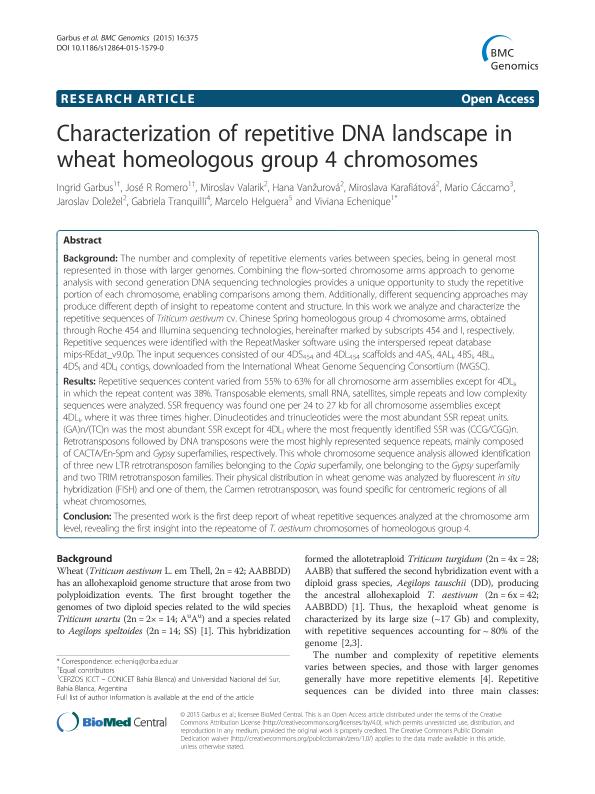Mostrar el registro sencillo del ítem
dc.contributor.author
Garbus, Ingrid

dc.contributor.author
Romero, José Rodolfo

dc.contributor.author
Valarik, Miroslav
dc.contributor.author
Vanžurová, Hana
dc.contributor.author
Karafiátová, Miroslava
dc.contributor.author
Cáccamo, Mario
dc.contributor.author
Doležel, Jeroslav
dc.contributor.author
Tranquilli, Gabriela
dc.contributor.author
Helguera, Marcelo
dc.contributor.author
Echenique, Carmen Viviana

dc.date.available
2017-01-17T19:59:06Z
dc.date.issued
2015-04
dc.identifier.citation
Garbus, Ingrid; Romero, José Rodolfo; Valarik, Miroslav ; Vanžurová, Hana ; Karafiátová, Miroslava ; et al.; Characterization of repetitive DNA landscape in wheat homeologous group 4 chromosomes; Biomed Central; Bmc Genomics; 16; 4-2015; 1-30
dc.identifier.issn
1471-2164
dc.identifier.uri
http://hdl.handle.net/11336/11495
dc.description.abstract
Background: The number and complexity of repetitive elements varies between species, being in general most represented in those with larger genomes. Combining the flow-sorted chromosome arms approach to genome analysis with second generation DNA sequencing technologies provides a unique opportunity to study the repetitive portion of each chromosome, enabling comparisons among them. Additionally, different sequencing approaches may produce different depth of insight to repeatome content and structure. In this work we analyze and characterize the repetitive sequences of Triticum aestivum cv. Chinese Spring homeologous group 4 chromosome arms, obtained through Roche 454 and Illumina sequencing technologies, hereinafter marked by subscripts 454 and I, respectively. Repetitive sequences were identified with the RepeatMasker software using the interspersed repeat database mips-REdat_v9.0p. The input sequences consisted of our 4DS454 and 4DL454 scaffolds and 4ASI, 4ALI, 4BSI, 4BLI, 4DSI and 4DLI contigs, downloaded from the International Wheat Genome Sequencing Consortium (IWGSC). Results: Repetitive sequences content varied from 55% to 63% for all chromosome arm assemblies except for 4DLI, in which the repeat content was 38%. Transposable elements, small RNA, satellites, simple repeats and low complexity sequences were analyzed. SSR frequency was found one per 24 to 27 kb for all chromosome assemblies except 4DLI, where it was three times higher. Dinucleotides and trinucleotides were the most abundant SSR repeat units. (GA)n/(TC)n was the most abundant SSR except for 4DLI where the most frequently identified SSR was (CCG/CGG)n. Retrotransposons followed by DNA transposons were the most highly represented sequence repeats, mainly composed of CACTA/En-Spm and Gypsy superfamilies, respectively. This whole chromosome sequence analysis allowed identification of three new LTR retrotransposon families belonging to the Copia superfamily, one belonging to the Gypsy superfamily and two TRIM retrotransposon families. Their physical distribution in wheat genome was analyzed by fluorescent in situ hybridization (FISH) and one of them, the Carmen retrotransposon, was found specific for centromeric regions of all wheat chromosomes. Conclusion: The presented work is the first deep report of wheat repetitive sequences analyzed at the chromosome arm level, revealing the first insight into the repeatome of T. aestivum chromosomes of homeologous group 4.
dc.format
application/pdf
dc.language.iso
eng
dc.publisher
Biomed Central

dc.rights
info:eu-repo/semantics/openAccess
dc.rights.uri
https://creativecommons.org/licenses/by-nc-sa/2.5/ar/
dc.subject
Dna Sequencing
dc.subject
Wheat
dc.subject
Repeteome
dc.subject
Ssr
dc.subject.classification
Otras Ciencias Biológicas

dc.subject.classification
Ciencias Biológicas

dc.subject.classification
CIENCIAS NATURALES Y EXACTAS

dc.title
Characterization of repetitive DNA landscape in wheat homeologous group 4 chromosomes
dc.type
info:eu-repo/semantics/article
dc.type
info:ar-repo/semantics/artículo
dc.type
info:eu-repo/semantics/publishedVersion
dc.date.updated
2017-01-13T20:06:18Z
dc.journal.volume
16
dc.journal.pagination
1-30
dc.journal.pais
Reino Unido

dc.journal.ciudad
Londres
dc.description.fil
Fil: Garbus, Ingrid. Consejo Nacional de Investigaciones Científicas y Técnicas. Centro Científico Tecnológico Bahía Blanca. Centro de Recursos Naturales Renovables de la Zona Semiárida(i); Argentina. Universidad Nacional del Sur; Argentina
dc.description.fil
Fil: Romero, José Rodolfo. Consejo Nacional de Investigaciones Científicas y Técnicas. Centro Científico Tecnológico Bahía Blanca. Centro de Recursos Naturales Renovables de la Zona Semiárida(i); Argentina. Universidad Nacional del Sur; Argentina
dc.description.fil
Fil: Valarik, Miroslav . Centre of the Region Haná for Biotechnological and Agricultural Research. Institute of Experimental Botany; República Checa
dc.description.fil
Fil: Vanžurová, Hana . Centre of the Region Haná for Biotechnological and Agricultural Research. Institute of Experimental Botany; República Checa
dc.description.fil
Fil: Karafiátová, Miroslava . Centre of the Region Haná for Biotechnological and Agricultural Research. Institute of Experimental Botany; República Checa
dc.description.fil
Fil: Cáccamo, Mario . Norwich Research Park. The Genome Analysis Centre; Reino Unido
dc.description.fil
Fil: Doležel, Jeroslav . Centre of the Region Haná for Biotechnological and Agricultural Research. Institute of Experimental Botany; República Checa
dc.description.fil
Fil: Tranquilli, Gabriela . Instituto Nacional de Tecnología Agropecuaria. Centro Nacional de Investigaciones Agropecuarias. Centro de Investigación de Recursos Naturales. Instituto de Recursos Biológicos; Argentina
dc.description.fil
Fil: Helguera, Marcelo . Instituto Nacional de Tecnología Agropecuaria. Centro Regional Córdoba. Estación Experimental Agropecuario Marcos Juarez; Argentina
dc.description.fil
Fil: Echenique, Carmen Viviana. Consejo Nacional de Investigaciones Científicas y Técnicas. Centro Científico Tecnológico Bahía Blanca. Centro de Recursos Naturales Renovables de la Zona Semiárida(i); Argentina. Universidad Nacional del Sur; Argentina
dc.journal.title
Bmc Genomics

dc.relation.alternativeid
info:eu-repo/semantics/altIdentifier/url/http://bmcgenomics.biomedcentral.com/articles/10.1186/s12864-015-1579-0
dc.relation.alternativeid
info:eu-repo/semantics/altIdentifier/doi/http://dx.doi.org/10.1186/s12864-015-1579-0
Archivos asociados
